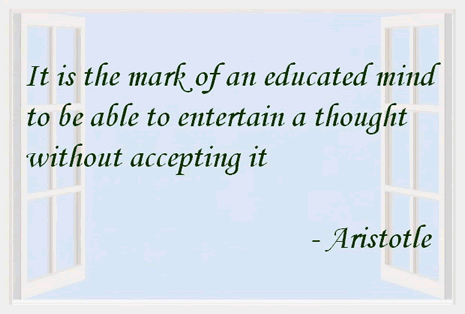To educate for individuality is to allow the pupil's inner capacities to develop to their fullest extent.
Ideas have the power to change the world. The ultimate aim of education is not acquisition of any specific type of knowledge, but rather acquisition of the curiosity to inquire and question, to critically analyze and originally formulate concepts and conclusions at variance with established authority and conventional wisdom.

The Challenge
The greatest obstacle to original thinking is blind superstitious acceptance of what is taught based on faith rather than true understanding, acceptance of intellectual authority rather than free exploration of ideas and possibilities by the power of mind. In the words of the eminent Physicist educator Arnold Arons, “The great majority of our students have accepted these propositions on faith. They have almost never examined evidence or articulated in their own words any of the reasons that lead us to hold these views. They received them as end results from authority and pass them on to others in exactly the same manner… never discriminated between assertions such as `scientists know that…’ and instances where they have followed at least some of the evidence and understood how the particular result was validated and accepted. Before submerging them in further assertions of end results, it is essential to lead them to an understanding of the basis for some of our most fundamental and far reaching ideas.”
Fostering Thinking in Education
- Higher level thinking can be developed only when the principal goal of education is to awaken the student’s interest, curiosity and capacity to question, rather than to transfer information and understanding.
- For a learning environment to be conducive for the development of higher order thinking, the following elements have to be present:
- stimulating students’ interest
- creating meaningful open-ended discussion
- exposure to thoughts and views of others
- encouraging open-mindedness, honesty and trust in the classroom so students will willingly express their individual opinions and not feel the pressure to conform to the teacher’s or the majority’s opinion
- Raising questions without providing answers
- Embracing students’ differences and respecting divergent thinking
- Discussing about ideas that challenge existing societal norms and providing them with new perspectives to reconcile with existing beliefs
- Emphasizing that questions have more than one answer to problems and problems have more than one solution
- Visualisation is a potentially powerful educational tool. For example, enhancement of thinking can be achieved through visualising changes in context
- The essential basis for developing original thinking is the realization that there are no right and wrong answers, but only many partially true elements of a wider truth that is beyond our capacity to perceive and express. The capacity to discover the truth in many different and apparently conflicting viewpoints, to reconcile apparent contradictions, and discover commonalty where others see only contrast are mental perspectives that promote original thinking that borders on genius.
Further Reading
- A. B. Arons, “Cultivating the capacity for formal reasoning: Objectives and procedures in an introductory physical science course,” American Journal of Physics 44, no.9 (1976): 834-838
- Ashok Natarajan, “Original thinking,” Cadmus 1, no.4 (2012): 23-35
- C. Meyers, Teaching students to think critically (San Francisco: Jossey-Bass, 1986)
- Garry Jacobs and Ivo Šlaus, “Recognizing unrecognized genius,” Cadmus 1, no.3 (2012): 1-5
- Paul Howard-Jones, “Fostering creative thinking: co-constructed insights from neuroscience and education” Escalate
- James Haywood Rolling Jr., “Essay Review of “The Arts and the Creation of Mind” by Elliot Eisner,” Surface 1st January 2006.
